#janiform
Text
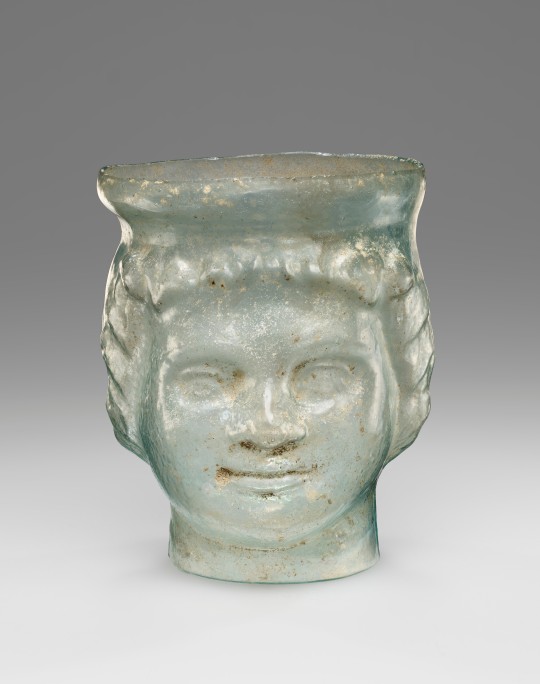
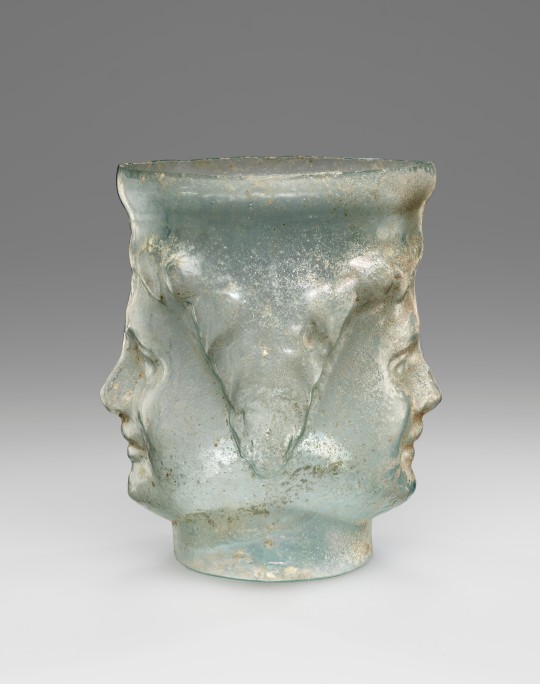
Mold-blown glass flask with janiform decoration
Roman, 1st century A.D.
J. Paul Getty Museum
#ancient glass#janiform#Ancient Rome#Roman#art#glass#green glass#Getty Museum#J. Paul Getty Museum#Imperial Period
910 notes
·
View notes
Photo

Janiform demon girl. The faces do not have separate consciousnesses, this is only one person, but they can be moved independently. All limbs and digits are double jointed, allowing them to face the "correct" direction respective to each face whenever desired.
24 notes
·
View notes
Text
https://blogs.getty.edu/iris/an-investigation-of-black-figures-in-classical-greek-art/
https://aeon.co/essays/how-does-an-ancient-greek-cup-challenge-anti-black-racism
Im getting sick of the "black ppl casted in Greco-Roman setting show is historically inaccurate" discourse that happens all the time so here's a couple articles written by classics professor Sara Derbew who is the first person to really analyze black figures in greek art and offer interpretations that do not fall into that black vs white thinking that isn't "black = inferior"
#theres so many interesting things in these articles#i didnt know that cover for benjamin isaacs book was made to have that black and white dichotomy#when it didnt exist in the original art piece#she goes into why we should refer to them as black glazed and not black or african which is generalizing and harmful#and i remember my professor showing us those janiform cups and thinking wow that looks like a caricature and its interesting shes#like why do we assume its negative representation why do we assume its being contrasted to the lighter figure#what if its a god what if its a hero#are eyes r immediately drawn to the black figures in a way the society it was made in would have not#its so important to really combat our initial assumptions when we see art like that#when we see those janiform cups automatically u think its contrasting#but what if the two figures r actually complimentary
5 notes
·
View notes
Text


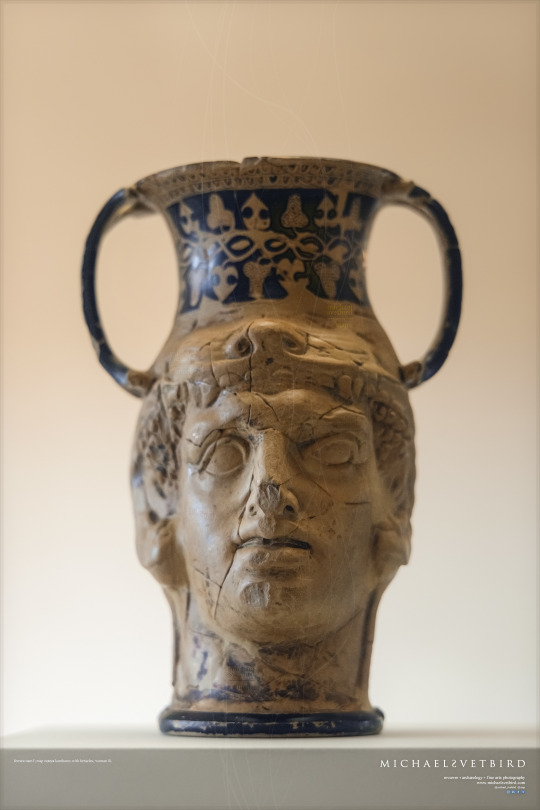
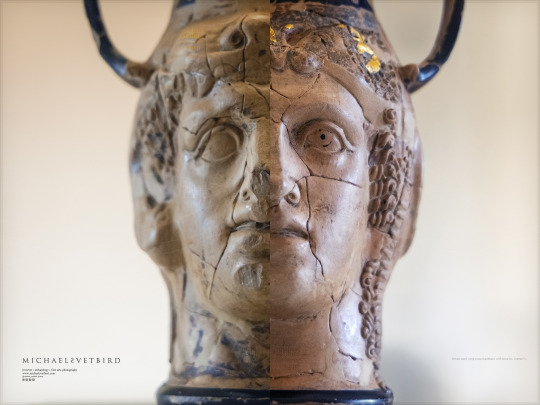
HERACLES + WOMAN:
Etruscan terracotta janiform Kantharos with the heads of Heracles and a Woman [possibly Athena, Omphale or an Amazon, as IDed by MANF]
By the Clusium Group [Etruscan workshop]
Ca 300 BC.
From Tomb 1029B, the Valle Pega, Chiusi area [near Ferrara], Spina.
Museo Archeologico Nazionale di Ferrara | MANF
[1st Fl. Sala XII]
• Web : http://www.archeoferrara.beniculturali.it/index.aspx?lng=ENG
• FB : https://www.facebook.com/museo.archeologico.ferrara
• IG : @museo_archeologico_ferrara
• X : @ArcheoFerrara
MANF | Michael Svetbird phs©msp | 21|02|24 6300X4200 600 [I.-III.]
The photographed object is collection item of MANF, photos are copyrighted
[non commercial use | sorry for the watermarks]
.
#ferrara#emilia romagna#archaeological museum#etruscan#kantharos#red figure pottery#vase painting#ancient pottery#pottery#etruscans#ancient art#antiquity#ancient#archaeology#museology#museum#mythology#greek mythology#art history#antiquities#heritage#culture#heracles#athena#omphale#amazon#art photography#archaeology photography#museum photography#michaelsvetbird
73 notes
·
View notes
Photo



The 'Beth Shean' Marble Bust
2nd-3rd century AD
H. 47.5 x w. 32 x d. 41 cm
A monumental marble janiform herm of marmo lunense marble depicting the heads of Bacchus and Ariadne. Bacchus wears a fillet across his forehead, the centrally parted hair dressed with a rich garland of ivy leaves with two frontal clusters of berries, vine leaves, and bunches of grapes hanging behind the ears. Ariadne has softer features and a fuller face, her wavy hair is also centrally parted and dressed with delicate ivy berries and leaves.
#The 'Beth Shean' Marble Bust#2nd-3rd century AD#marble#marble bust#marble statue#ancient artifacts#archeology#archeolgst#history#history news#ancient history#ancient culture#ancient civilizations#ancient rome#roman history#roman empire#roman art
79 notes
·
View notes
Text
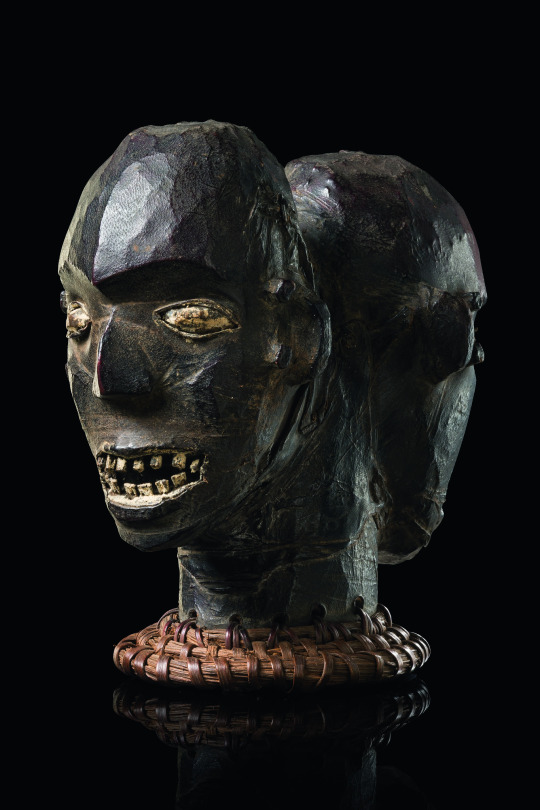
Janiform dance crest
Cameroon, Anyang
Zemanek Munster
21 notes
·
View notes
Text

A janiform terracotta masterpiece 520–510 ΒC, from Greece with "kalos inscription (καλός)"
A kalos inscription is a form of epigraph found on Attic vases and graffiti in antiquity, mainly during the Classical period from 550 to 450 BC. The word kalos (καλός) means "beautiful".
123 notes
·
View notes
Text
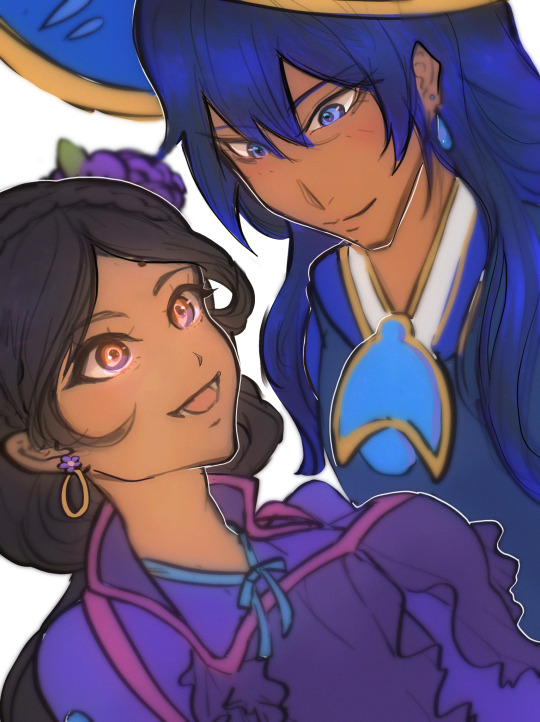
💖💜🌸Ana & Nalu💧💙💖
LOOK AT THIS SPECTACULAR, BEAUTIFULLY, BREATHTAKING LOVELY GIFT FROM THE WONDERFUL @janiforme FOR MY BIRTHDAY!!!💖🥰🥳💕
I LOVE THEIR LITTLE DETAILS 🌸💧 & THEIR WHOLE ✨ GORGEOUS ✨STUNNING ✨ ELEGANT DESIGNED OUTFITS! ✨💜🥰🥹💙✨THE WAY ANA & NALU ARE LOOKING AT EACH OTHER!!!! 💜💙AHHH MY HEART FLUTTERS!!!💖💜💗💙💖
AHHH THANK YOU SO MUCH JANI!!!💜🥳💖🥰💕🥹💗😭💙
2 notes
·
View notes
Text

19th C. BMC electrotype - Tenedos AR tetradrachm - Janiform & Axe
5 notes
·
View notes
Text
An article of Pr. Sarah Debrew on Black Figures in Classical Greek Art
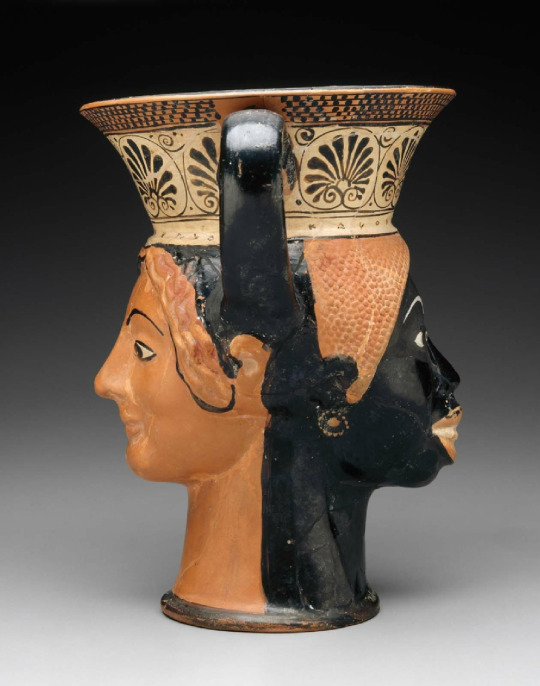
An Athenian kantharos, c.500 BCE, Boston Museum of Fine Arts 98.926. This form of cup with two heads is known as 'janiform', here two women. Source: http://panoplyclassicsandanimation.blogspot.com/2020/10/black-history-month-black-and-white.html
I have found a very interesting article of Sarah F. Debrew with the title An Investigation of Black Fifures in Classical Greek Art. Its subtitle is “Ancient Greece’s visual heritage included representations of black people that nimbly provoked and cut accross hierarchies”. The article criticizes modern interpretations or distorions of ancient Greek art, which present the latter as portraying Black people exlusively as servants or as physical threat, and shows that the depiction of Blackness in Classical Greek art is in fact of much more various character than thought by many.
Unfortunately the source does not allow the reproduction of Pr. Debrew’s text, but one can read it on https://blogs.getty.edu/iris/an-investigation-of-black-figures-in-classical-greek-art/

Sarah F. Debrew, Associate Professor of Classics, Stanford University
3 notes
·
View notes
Text

janiform demon girl
15 notes
·
View notes
Photo
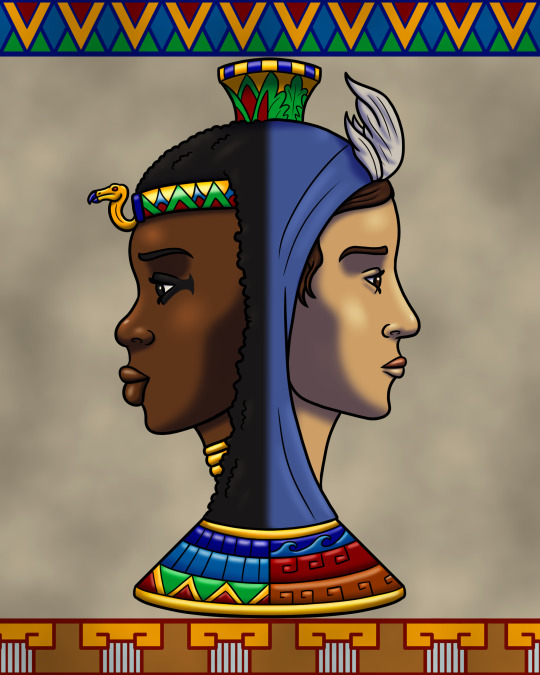
This is a representation of the famous Egyptian goddess Auset (better known as Isis) that is inspired by assorted double-faced “janiform” vases from the ancient Mediterranean. On the left side would be the face of the goddess as a native Egyptian woman, whereas the face on the right is based on how the Romans would depict her once they adopted her cult as one of their own after annexing Egypt.
#Isis#Auset#goddess#mythology#kemet#ancient egypt#egyptian#african#black woman#woman of color#woc#rome#ancient rome#roman#italian#janiform#digital art#art
150 notes
·
View notes
Photo

Attic janiform red-figure aryballos in the shape of women’s heads, bearing the inscription Epilykos kalos ( “Epilykos is handsome/beautiful”). Tentatively attributed to the painter Skythes; ca. 510-500 BCE. Now in the Louvre. Photo credit: © Marie-Lan Nguyen / Wikimedia Commons.
#classics#tagamemnon#Ancient Greece#Archaic Greece#art#art history#ancient art#Greek art#Ancient Greek art#Archaic Greek art#vase painting#ceramics#red-figure#aryballos#janiform#Scythes#Skythes#animals in art#owl#owls#Louvre#Louvre Museum#Musee du Louvre
880 notes
·
View notes
Photo

#janiform#janiform drinking cup#drinking cup#face#face jug#face cup#greek#ancient greece#early classical period#480 bce#attributed to the syriskos painter#syriskos painter
3 notes
·
View notes
Text

Tahitian Figure from a Flywhisk
The attribution of objects from the Society Islands has long been the subject of some uncertainty. As David King notes, this difficulty arises in part because "communication and exchange among the Australs-Cooks-Societies probably started around the 15th century, so objects collected on any particular island may or may not have been made there, or may have been made by people from another island living there."1 Steven Hooper states that by the eighteenth century (if not before) specialist artists in the Austral Islands created "important ritual equipment for chiefs of the Society Islands."2 Nor was the confusion helped by a tendency on the part of early English observers to attribute all objects from these Islands to "Otaheite", the beau ideal of the South Sea Islands in the imagination of the late eighteenth century. That this uncertainty has persisted is evident in the fact that when the Barnets acquired this sculpture from Ralph Nash it was described as a "Rarotonga Godstick". In fact, this important sculpture is, to our knowledge, the only example in private hands of the exceptionally rare corpus of Society Islands flywhisks which terminate in single anthropomorphic figures. In his study on the more abundant corpus of janiform flywhisks, Roger Rose notes that single figure flywhisks may be "regarded as the [type of] fly whisk used in the Society Islands at European contact."3 Flywhisks were not merely practical implements – although swarms of flies in Tahiti were much remarked upon by eighteenth century visitors – they served the role of family and household Gods, and were also symbols of rank which were brandished during oratory. A firm attribution to the Society Islands, and more specifically to Tahiti, is supported by a comparison of the Barnet flywhisk with the wider corpus of firmly identified Tahitian sculpture, as well as with the smaller corpus of single figure flywhisks. Particularly characteristic of Tahitian sculpture are the squared shoulders, the concave back, the firm, lean jaw, and semi-circular ears. In the case of the Barnet flywhisk these features are executed with the definite confidence of the accomplished craftsman. The form of the ears flows effortlessly into the line of the jaw, and the outline of the sculpture is fluid and rhythmic, with parabolic forms arcing in contrast to strong, straight lines. The profile of the Barnet flywhisk recalls that of the double figure, probably from a canoe, in the British Museum (inv. no. Oc,TAH.60; see fig. 1).4 The straight, slightly furrowed brow is distinctive, as is the asymmetric position of the hands, which is unique within the corpus of flywhisks. These two traits impart a certain tenderness to the sculpture, and are reminiscent of the standing figure in the Pitt Rivers Museum, Oxford (inv. no. 1886.1.1424)5, collected by the naturalists Johann Reinhold and Georg Forster during Cook's second voyage in 1773-1774.
Sotheby’s
7 notes
·
View notes
Photo
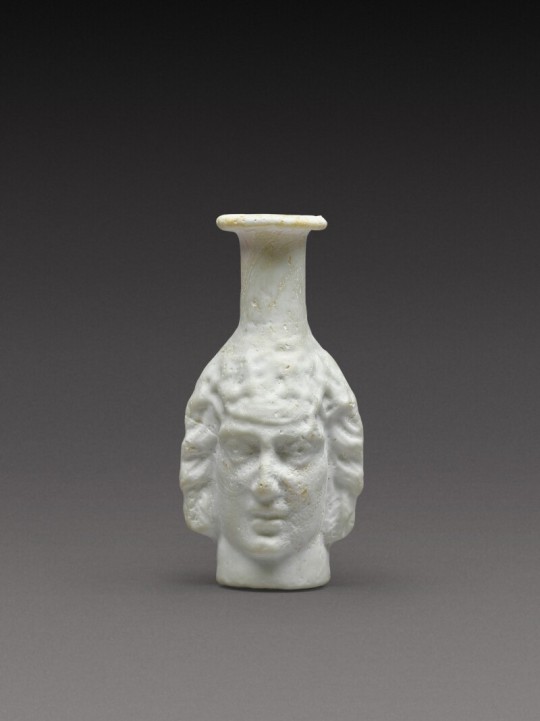
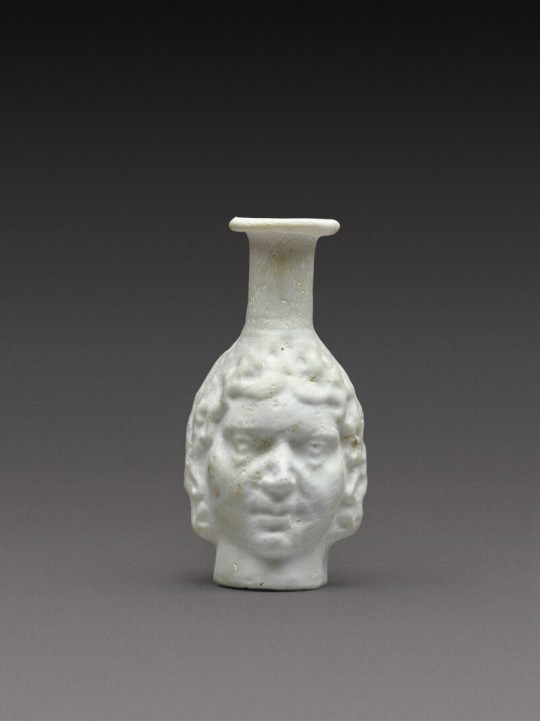
A Roman Opaque White Mould-Blown Janiform Glass Flask
Circa 1st/2nd century AD
The cylindrical neck with everted rim and inward-folded lip with a plump-faced youth and a thin-faced man wearing a fillet on either side.
Height 7.4 cm.
#A Roman Opaque White Mould-Blown Janiform Glass Flask#Circa 1st/2nd century AD#art#artist#art work#art news#history#history news#ancient history#ancient culture#ancient civilizations#ancient rome#roman history#roman empire#ancient artifacts
27 notes
·
View notes